-
 "A Firefly by Any Other Name Would Still Glow as Brightly"
"A Firefly by Any Other Name Would Still Glow as Brightly" Rochester Evening School Mascot, from RIT Evening Student Association newsletter, The Image. September 1968 issue, From RIT Evening School Records, RIT Arc. 0476, Box 2, Folder 17
Shrouded in mystery and collective intrigue, a presumably under-appreciated mascot once laid claim to the RIT evening college. Neither tiger nor Techman, this being was brief and, nearly forgotten. But, as they should, these evening college memoirs live on; and with this recent finding, this topic will not dissipate so soon.
The mascot was discovered in a September issue of a 1968 RIT Evening Student Association newsletter known as The Image (RIT Arc. 0476, Box 2, Folder 17). Here, information about the school, different faculty, college events, general news, etc. is shared on a student-student platform. Since this is a newspaper that primarily addresses evening college activity, it only makes sense that it should advertise evening school customs—including, but not limited to, a personal mascot. What are the types of creatures you think of in the night? What nocturnal names do you know? Owls, bats, lemurs, cats—the list goes on. But what could present a bit more flare? Something flashy to get students excited. What symbol would serve this position better, than a firefly?
Fireflies are not only visually appealing, but also serve as a quiet source for inspiration. A sort of intrigue that could symbolize thought and knowledge. Wouldn’t this be an area of interest, one to inspire you to learn something as simple as: why does a firefly glow? What is the science behind that luminescence? What evolution caused such unique traits in these insects, and other creatures with seemingly similar qualities? Are they relatable to one another? RIT has always been an advocate of continued education. One pursues knowledge for the sake of learning, growing, and subsequently achieving more. Is a firefly mascot a small promotion of this precedent, or, perhaps, just a playful reminder that you’re a member of a community which takes their classes after the sun has set? While this little bug only held its reign for about four years, we'll hold belief that it was the latter. “A firefly by any other name would still glow as brightly,” (firefly.org).
-
 Faculty Handbook and Classbook
Faculty Handbook and Classbook This is a faculty handbook from 1967 for workers at the Evening College at Rochester Institute of Technology. Shown at the bottom as well, is the address of the school. What was included in this book was an introduction to the evening college, wait their goals were, a list of their responsibilities as a faculty member, location of where they are able to acquire materials needed for their classes, how parking works, etc.
-
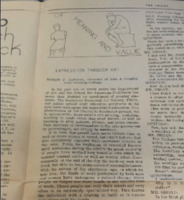 Article From "The Image"
Article From "The Image" An April 4th, 1967 article from "the Image," a student run newspaper at RIT. The article talks about the increase of evening students in arts programs and possible reasons why people seem to to be more interested in creating and working with their hands.
-
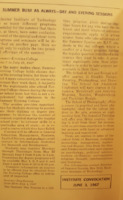 "Summer Busy as Always - Day and Evening Sessions"
"Summer Busy as Always - Day and Evening Sessions" A common theme in the R.I.T. Notebook issues is registration reminders. This issue advertises the Summer Evening College programs (from June 7 to July 28) and the Summer Day Session (from June 26 to Aug. 4). In 1967, summer evening courses were offered in Management, Business, Applied Sciences and General Education courses. The summer day session offered more courses from wider concentrations. Courses were offered in the School of Art and Design, the School of Photography, and various courses in Business just to name a few.
-
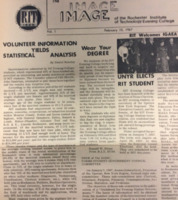 Image Newspaper Student Survey
Image Newspaper Student Survey On February 15, 1967 Image student newspaper conducted a survey to develop a greater understanding of the Evening School student demographics. The statistical analysis reveals employment status, and motivational reasons for attending classes self-reported by Evening School students at this time.
Additionally, the survey provides insight into the marital and relationship status, student life, and socializing activities provided on campus.
-
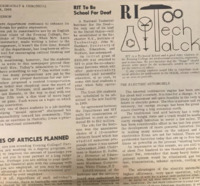 The National Technical Institute for the Deaf
The National Technical Institute for the Deaf From student-run evening school Newsletter The Image, on of the first official announcements of the National Technical Institute for the Deaf, an Institution located on RIT's Henrietta campus.
-
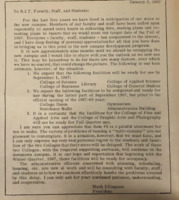 The Henrietta Campus
The Henrietta Campus An announcement in student-run evening school newsletter The Image concerning the new RIT Henrietta campus--College of Fine & Applied Arts, College of Graphic Arts, College of Photography--New facilities not yet complete, must remain on downtown campus while all other schools make the move.
-
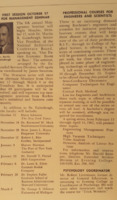 8th Annual Management Seminar
8th Annual Management Seminar This issue reminds students of the list the dates and courses for the Management Seminar. It gave a list of the speakers which lets us know the school's connections. On the other side of this document, we also learn that the Evening College had set apart some seminars for graduates who wanted to be updated on certain practices or advances in their fields.
-
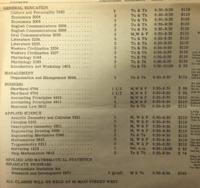 Course Offerings
Course Offerings This picture shows a section of “The Image” which is the newspaper for the Rochester Institute of Technology evening school. What this part of the newspaper displays is a list of the classes offered at the evening school. They are separated into general education, management, business, applied science, and applied and mathematical statistics. Also included with each course is the amount of credits it is worth, the days that it is offered, what times on those days, and the price for that course. It is also noted at the bottom that all classes are located at 50 Main Street West.
-
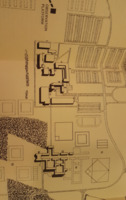 R.I.T. Map in 1966
R.I.T. Map in 1966 The issue opens with Dean Robert D. Pease, the first dean if the College of Continuing Education, inviting students to check out the campus's new location on Jefferson Road. This specific notebook actually provides an older map of R.I.T. even before the campus was completed. According to the legend, the locations on this map are (2) Science, (3) Applied Science, (4) Fine and Applied Arts, (5) Graphic Arts and Photography, (6) General Studies, (7) Library, (9) Evening School, (11) Union and Pool, (12) Physical Education and Athletic Center, (13) Athletic Fields, (14) Dining Hall, (15) Dorms, and (16) Future dorms. How many of these locations have stood the same?
-
 Course Offerings
Course Offerings These were the class offerings for evening classes during the spring quarter. Programs include: accounting, business administration, criminal justice, fine & applied art, general education (communications, humanities, and social sciences), management, math, photography, real estate, secretarial and social work, among others. The range of classes offered speaks to the type of student at the time. Learning trade skills and specialized professions, like real estate or secretarial, was the norm at this time. Unlike in the winter quarter, no off campus classes were offered during the spring quarter.
-
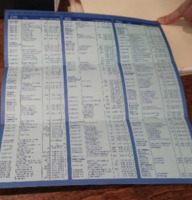 Course Offerings
Course Offerings These were the class offerings for evening classes during the winter quarter. Programs include: accounting, business administration, criminal justice, fine & applied art, general education (communications, humanities, and social sciences), management, math, photography, real estate, secretarial and social work, among others. There were also certain classes available off campus at Olympia High School in Greece, and R.L. Thomas High School in Webster. The range of classes offered speaks to the type of student at the time. Learning trade skills and specialized professions, like real estate or secretarial, was the norm at this time. RIT also tried to make it easier for some students to get to class by offering off campus locations.
-
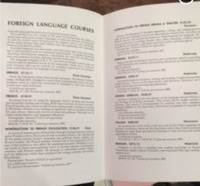 Foreign Language Courses
Foreign Language Courses A booklet of the Foreign Language courses offered at the Evening College. Here shown a foreign language course booklet from Feb 26th, 1964 that were offered at the RIT Evening College. It gives a brief overview of the advantages of learning a new language as well as how the program itself has evolved from its start. What is intriguing about the course offerings is that they are not only courses teaching the language, but some teach the history of that country or the different culture. In addition to the course name, number, and professor, it provides a summary of what would be taught/learned, days and times it is offered, and the cost.
-
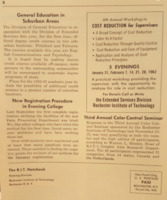 Cost Reduction for Supervisors
Cost Reduction for Supervisors Here is an example of some of the courses and seminars the Evening College offered. The Cost Reduction workshop is one of the courses directed at individuals with careers who wanted to learn or improve a skill. Another seminar, the Color Control seminar, saw 40 participants representing 31 companies from 14 states, Canada, and the Netherlands.
-
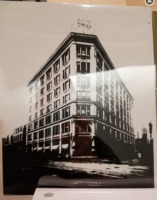 Duffy Towers Exterior
Duffy Towers Exterior The Exterior of the Duffy Towers building that would one day become part of RIT's Downtown Campus. Originally the Duffy Towers building, 50 West Main Street would eventually be bought by The Rochester Institute of Technology and converted into and educational space. From this location students could take classes in the applied arts, mechanical drafting, and many more. The exterior of the building largely stayed the same yet over the years several renovations took place to accommodate the RIT students learning and working in the building.
-
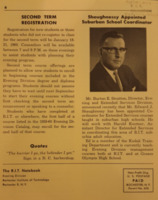 Shaughnessy Appointed Suburban School Coordinator
Shaughnessy Appointed Suburban School Coordinator Along with another registration reminder, this article announces Mr. Edward J. Shaughnessy as Coordinator for Extended Services courses taught in suburban high schools in the greater Rochester area. These high schools served as locations the Evening College taught at. "The hurrier I go, the behinder I get." -- sign in a N.C. barbershop
-
 1961 Diploma and A.A.S. Degree Candidates
1961 Diploma and A.A.S. Degree Candidates This issue of the R.I.T. Notebook featured two pages dedicated to the 1961 Evening College candidates for Diplomas and the Associates in Applied Sciences(A.A.S.). In 1961, the A.A.S. had its seventh graduating class for the Industrial Technology program and the first graduating class in the Industrial Management and General Business programs. This document gives us insight what programs were offered and how popular those programs were.
-
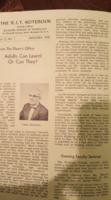 From the Dean's Desk
From the Dean's Desk Dean Stratton speaks about the importance of the Evening College and continuing education at R.I.T. He believed that adults were constantly looking to learn. The Evening College allowed for adults to take courses on schedules that could work around their work and family schedules. The Evening College serviced 6000 adult students in the Rochester area. Courses ranged I'm studies including Graphic Arts, Air Conditioning, Chemistry, and Accounting. These classes and their turnouts show how great the impact was on the community.
-
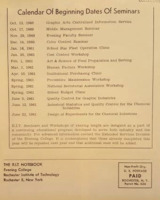 Calendar of Beginning Dates of Seminars
Calendar of Beginning Dates of Seminars Here is a list of seminars and courses offered in from October 1960 to June 1961.
-
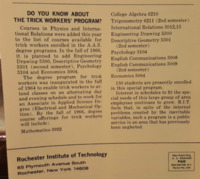 Trick Worker's Program
Trick Worker's Program Do you know about the Trick Worker's Program? The Evening College offered a program for those who worked shift jobs proving the school's focus on catering to students with careers. This issue explains that they planned on having an alternating day-evening schedule by 1964. This article also features classes the curriculum planned to have 1966.
-
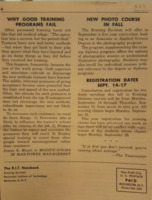 1959 Registration Dates and New Photo Course
1959 Registration Dates and New Photo Course
-
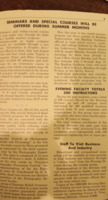 A Large, Professional Student Body
A Large, Professional Student Body This is the R.I.T. Notebook's first publication. By this time, R.I.T. had not yet moved to its current location. The Evening College seems to be advertised to specific companies R.I.T. had relationships with. Many of the seminars or classes have multiple representatives from repeating companies, Kodak for example. By June of 1959, the Evening College had already enrolled 4,776 students representing 808 companies. There were also specific programs geared towards Navy Personnel.
-
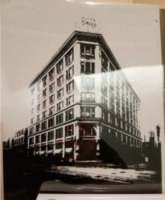 Original Duffy Powers Building
Original Duffy Powers Building The Duffy Powers building was originally the largest department store in Rochester, circa 1900. The Duffy-Powers Company went bankrupt in 1932 because of the Great Depression. RIT ultimately acquired this building as its main campus building in the 1950s.
-
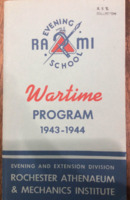 1943-1944 RAMI Wartime Program
1943-1944 RAMI Wartime Program The logo of the 1943-44 RAMI (Rochester Athenaeum and Mechanic's Institue) features a beaker, a paint brush, and a clamp which shows the vast array of courses and programs offered. The program details course offerings during World War II. It is a part of RIT Evening School records, RITArc.0476.
-
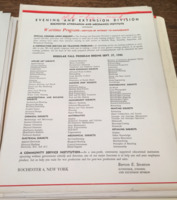 A Community Service Institution
A Community Service Institution Course pamphlets with a propogandic, wartime nature continue. RIT caters to a sense of community, emphasizing that the institute is a non-profit, community supported educational institution to help students and their employees produce. Production caters to wartime and post-war sales.
 "A Firefly by Any Other Name Would Still Glow as Brightly" Rochester Evening School Mascot, from RIT Evening Student Association newsletter, The Image. September 1968 issue, From RIT Evening School Records, RIT Arc. 0476, Box 2, Folder 17 Shrouded in mystery and collective intrigue, a presumably under-appreciated mascot once laid claim to the RIT evening college. Neither tiger nor Techman, this being was brief and, nearly forgotten. But, as they should, these evening college memoirs live on; and with this recent finding, this topic will not dissipate so soon. The mascot was discovered in a September issue of a 1968 RIT Evening Student Association newsletter known as The Image (RIT Arc. 0476, Box 2, Folder 17). Here, information about the school, different faculty, college events, general news, etc. is shared on a student-student platform. Since this is a newspaper that primarily addresses evening college activity, it only makes sense that it should advertise evening school customs—including, but not limited to, a personal mascot. What are the types of creatures you think of in the night? What nocturnal names do you know? Owls, bats, lemurs, cats—the list goes on. But what could present a bit more flare? Something flashy to get students excited. What symbol would serve this position better, than a firefly? Fireflies are not only visually appealing, but also serve as a quiet source for inspiration. A sort of intrigue that could symbolize thought and knowledge. Wouldn’t this be an area of interest, one to inspire you to learn something as simple as: why does a firefly glow? What is the science behind that luminescence? What evolution caused such unique traits in these insects, and other creatures with seemingly similar qualities? Are they relatable to one another? RIT has always been an advocate of continued education. One pursues knowledge for the sake of learning, growing, and subsequently achieving more. Is a firefly mascot a small promotion of this precedent, or, perhaps, just a playful reminder that you’re a member of a community which takes their classes after the sun has set? While this little bug only held its reign for about four years, we'll hold belief that it was the latter. “A firefly by any other name would still glow as brightly,” (firefly.org).
"A Firefly by Any Other Name Would Still Glow as Brightly" Rochester Evening School Mascot, from RIT Evening Student Association newsletter, The Image. September 1968 issue, From RIT Evening School Records, RIT Arc. 0476, Box 2, Folder 17 Shrouded in mystery and collective intrigue, a presumably under-appreciated mascot once laid claim to the RIT evening college. Neither tiger nor Techman, this being was brief and, nearly forgotten. But, as they should, these evening college memoirs live on; and with this recent finding, this topic will not dissipate so soon. The mascot was discovered in a September issue of a 1968 RIT Evening Student Association newsletter known as The Image (RIT Arc. 0476, Box 2, Folder 17). Here, information about the school, different faculty, college events, general news, etc. is shared on a student-student platform. Since this is a newspaper that primarily addresses evening college activity, it only makes sense that it should advertise evening school customs—including, but not limited to, a personal mascot. What are the types of creatures you think of in the night? What nocturnal names do you know? Owls, bats, lemurs, cats—the list goes on. But what could present a bit more flare? Something flashy to get students excited. What symbol would serve this position better, than a firefly? Fireflies are not only visually appealing, but also serve as a quiet source for inspiration. A sort of intrigue that could symbolize thought and knowledge. Wouldn’t this be an area of interest, one to inspire you to learn something as simple as: why does a firefly glow? What is the science behind that luminescence? What evolution caused such unique traits in these insects, and other creatures with seemingly similar qualities? Are they relatable to one another? RIT has always been an advocate of continued education. One pursues knowledge for the sake of learning, growing, and subsequently achieving more. Is a firefly mascot a small promotion of this precedent, or, perhaps, just a playful reminder that you’re a member of a community which takes their classes after the sun has set? While this little bug only held its reign for about four years, we'll hold belief that it was the latter. “A firefly by any other name would still glow as brightly,” (firefly.org). Faculty Handbook and Classbook This is a faculty handbook from 1967 for workers at the Evening College at Rochester Institute of Technology. Shown at the bottom as well, is the address of the school. What was included in this book was an introduction to the evening college, wait their goals were, a list of their responsibilities as a faculty member, location of where they are able to acquire materials needed for their classes, how parking works, etc.
Faculty Handbook and Classbook This is a faculty handbook from 1967 for workers at the Evening College at Rochester Institute of Technology. Shown at the bottom as well, is the address of the school. What was included in this book was an introduction to the evening college, wait their goals were, a list of their responsibilities as a faculty member, location of where they are able to acquire materials needed for their classes, how parking works, etc. Article From "The Image" An April 4th, 1967 article from "the Image," a student run newspaper at RIT. The article talks about the increase of evening students in arts programs and possible reasons why people seem to to be more interested in creating and working with their hands.
Article From "The Image" An April 4th, 1967 article from "the Image," a student run newspaper at RIT. The article talks about the increase of evening students in arts programs and possible reasons why people seem to to be more interested in creating and working with their hands. "Summer Busy as Always - Day and Evening Sessions" A common theme in the R.I.T. Notebook issues is registration reminders. This issue advertises the Summer Evening College programs (from June 7 to July 28) and the Summer Day Session (from June 26 to Aug. 4). In 1967, summer evening courses were offered in Management, Business, Applied Sciences and General Education courses. The summer day session offered more courses from wider concentrations. Courses were offered in the School of Art and Design, the School of Photography, and various courses in Business just to name a few.
"Summer Busy as Always - Day and Evening Sessions" A common theme in the R.I.T. Notebook issues is registration reminders. This issue advertises the Summer Evening College programs (from June 7 to July 28) and the Summer Day Session (from June 26 to Aug. 4). In 1967, summer evening courses were offered in Management, Business, Applied Sciences and General Education courses. The summer day session offered more courses from wider concentrations. Courses were offered in the School of Art and Design, the School of Photography, and various courses in Business just to name a few. Image Newspaper Student Survey On February 15, 1967 Image student newspaper conducted a survey to develop a greater understanding of the Evening School student demographics. The statistical analysis reveals employment status, and motivational reasons for attending classes self-reported by Evening School students at this time. Additionally, the survey provides insight into the marital and relationship status, student life, and socializing activities provided on campus.
Image Newspaper Student Survey On February 15, 1967 Image student newspaper conducted a survey to develop a greater understanding of the Evening School student demographics. The statistical analysis reveals employment status, and motivational reasons for attending classes self-reported by Evening School students at this time. Additionally, the survey provides insight into the marital and relationship status, student life, and socializing activities provided on campus. The National Technical Institute for the Deaf From student-run evening school Newsletter The Image, on of the first official announcements of the National Technical Institute for the Deaf, an Institution located on RIT's Henrietta campus.
The National Technical Institute for the Deaf From student-run evening school Newsletter The Image, on of the first official announcements of the National Technical Institute for the Deaf, an Institution located on RIT's Henrietta campus. The Henrietta Campus An announcement in student-run evening school newsletter The Image concerning the new RIT Henrietta campus--College of Fine & Applied Arts, College of Graphic Arts, College of Photography--New facilities not yet complete, must remain on downtown campus while all other schools make the move.
The Henrietta Campus An announcement in student-run evening school newsletter The Image concerning the new RIT Henrietta campus--College of Fine & Applied Arts, College of Graphic Arts, College of Photography--New facilities not yet complete, must remain on downtown campus while all other schools make the move. 8th Annual Management Seminar This issue reminds students of the list the dates and courses for the Management Seminar. It gave a list of the speakers which lets us know the school's connections. On the other side of this document, we also learn that the Evening College had set apart some seminars for graduates who wanted to be updated on certain practices or advances in their fields.
8th Annual Management Seminar This issue reminds students of the list the dates and courses for the Management Seminar. It gave a list of the speakers which lets us know the school's connections. On the other side of this document, we also learn that the Evening College had set apart some seminars for graduates who wanted to be updated on certain practices or advances in their fields. Course Offerings This picture shows a section of “The Image” which is the newspaper for the Rochester Institute of Technology evening school. What this part of the newspaper displays is a list of the classes offered at the evening school. They are separated into general education, management, business, applied science, and applied and mathematical statistics. Also included with each course is the amount of credits it is worth, the days that it is offered, what times on those days, and the price for that course. It is also noted at the bottom that all classes are located at 50 Main Street West.
Course Offerings This picture shows a section of “The Image” which is the newspaper for the Rochester Institute of Technology evening school. What this part of the newspaper displays is a list of the classes offered at the evening school. They are separated into general education, management, business, applied science, and applied and mathematical statistics. Also included with each course is the amount of credits it is worth, the days that it is offered, what times on those days, and the price for that course. It is also noted at the bottom that all classes are located at 50 Main Street West. R.I.T. Map in 1966 The issue opens with Dean Robert D. Pease, the first dean if the College of Continuing Education, inviting students to check out the campus's new location on Jefferson Road. This specific notebook actually provides an older map of R.I.T. even before the campus was completed. According to the legend, the locations on this map are (2) Science, (3) Applied Science, (4) Fine and Applied Arts, (5) Graphic Arts and Photography, (6) General Studies, (7) Library, (9) Evening School, (11) Union and Pool, (12) Physical Education and Athletic Center, (13) Athletic Fields, (14) Dining Hall, (15) Dorms, and (16) Future dorms. How many of these locations have stood the same?
R.I.T. Map in 1966 The issue opens with Dean Robert D. Pease, the first dean if the College of Continuing Education, inviting students to check out the campus's new location on Jefferson Road. This specific notebook actually provides an older map of R.I.T. even before the campus was completed. According to the legend, the locations on this map are (2) Science, (3) Applied Science, (4) Fine and Applied Arts, (5) Graphic Arts and Photography, (6) General Studies, (7) Library, (9) Evening School, (11) Union and Pool, (12) Physical Education and Athletic Center, (13) Athletic Fields, (14) Dining Hall, (15) Dorms, and (16) Future dorms. How many of these locations have stood the same? Course Offerings These were the class offerings for evening classes during the spring quarter. Programs include: accounting, business administration, criminal justice, fine & applied art, general education (communications, humanities, and social sciences), management, math, photography, real estate, secretarial and social work, among others. The range of classes offered speaks to the type of student at the time. Learning trade skills and specialized professions, like real estate or secretarial, was the norm at this time. Unlike in the winter quarter, no off campus classes were offered during the spring quarter.
Course Offerings These were the class offerings for evening classes during the spring quarter. Programs include: accounting, business administration, criminal justice, fine & applied art, general education (communications, humanities, and social sciences), management, math, photography, real estate, secretarial and social work, among others. The range of classes offered speaks to the type of student at the time. Learning trade skills and specialized professions, like real estate or secretarial, was the norm at this time. Unlike in the winter quarter, no off campus classes were offered during the spring quarter. Course Offerings These were the class offerings for evening classes during the winter quarter. Programs include: accounting, business administration, criminal justice, fine & applied art, general education (communications, humanities, and social sciences), management, math, photography, real estate, secretarial and social work, among others. There were also certain classes available off campus at Olympia High School in Greece, and R.L. Thomas High School in Webster. The range of classes offered speaks to the type of student at the time. Learning trade skills and specialized professions, like real estate or secretarial, was the norm at this time. RIT also tried to make it easier for some students to get to class by offering off campus locations.
Course Offerings These were the class offerings for evening classes during the winter quarter. Programs include: accounting, business administration, criminal justice, fine & applied art, general education (communications, humanities, and social sciences), management, math, photography, real estate, secretarial and social work, among others. There were also certain classes available off campus at Olympia High School in Greece, and R.L. Thomas High School in Webster. The range of classes offered speaks to the type of student at the time. Learning trade skills and specialized professions, like real estate or secretarial, was the norm at this time. RIT also tried to make it easier for some students to get to class by offering off campus locations. Foreign Language Courses A booklet of the Foreign Language courses offered at the Evening College. Here shown a foreign language course booklet from Feb 26th, 1964 that were offered at the RIT Evening College. It gives a brief overview of the advantages of learning a new language as well as how the program itself has evolved from its start. What is intriguing about the course offerings is that they are not only courses teaching the language, but some teach the history of that country or the different culture. In addition to the course name, number, and professor, it provides a summary of what would be taught/learned, days and times it is offered, and the cost.
Foreign Language Courses A booklet of the Foreign Language courses offered at the Evening College. Here shown a foreign language course booklet from Feb 26th, 1964 that were offered at the RIT Evening College. It gives a brief overview of the advantages of learning a new language as well as how the program itself has evolved from its start. What is intriguing about the course offerings is that they are not only courses teaching the language, but some teach the history of that country or the different culture. In addition to the course name, number, and professor, it provides a summary of what would be taught/learned, days and times it is offered, and the cost. Cost Reduction for Supervisors Here is an example of some of the courses and seminars the Evening College offered. The Cost Reduction workshop is one of the courses directed at individuals with careers who wanted to learn or improve a skill. Another seminar, the Color Control seminar, saw 40 participants representing 31 companies from 14 states, Canada, and the Netherlands.
Cost Reduction for Supervisors Here is an example of some of the courses and seminars the Evening College offered. The Cost Reduction workshop is one of the courses directed at individuals with careers who wanted to learn or improve a skill. Another seminar, the Color Control seminar, saw 40 participants representing 31 companies from 14 states, Canada, and the Netherlands. Duffy Towers Exterior The Exterior of the Duffy Towers building that would one day become part of RIT's Downtown Campus. Originally the Duffy Towers building, 50 West Main Street would eventually be bought by The Rochester Institute of Technology and converted into and educational space. From this location students could take classes in the applied arts, mechanical drafting, and many more. The exterior of the building largely stayed the same yet over the years several renovations took place to accommodate the RIT students learning and working in the building.
Duffy Towers Exterior The Exterior of the Duffy Towers building that would one day become part of RIT's Downtown Campus. Originally the Duffy Towers building, 50 West Main Street would eventually be bought by The Rochester Institute of Technology and converted into and educational space. From this location students could take classes in the applied arts, mechanical drafting, and many more. The exterior of the building largely stayed the same yet over the years several renovations took place to accommodate the RIT students learning and working in the building. Shaughnessy Appointed Suburban School Coordinator Along with another registration reminder, this article announces Mr. Edward J. Shaughnessy as Coordinator for Extended Services courses taught in suburban high schools in the greater Rochester area. These high schools served as locations the Evening College taught at. "The hurrier I go, the behinder I get." -- sign in a N.C. barbershop
Shaughnessy Appointed Suburban School Coordinator Along with another registration reminder, this article announces Mr. Edward J. Shaughnessy as Coordinator for Extended Services courses taught in suburban high schools in the greater Rochester area. These high schools served as locations the Evening College taught at. "The hurrier I go, the behinder I get." -- sign in a N.C. barbershop 1961 Diploma and A.A.S. Degree Candidates This issue of the R.I.T. Notebook featured two pages dedicated to the 1961 Evening College candidates for Diplomas and the Associates in Applied Sciences(A.A.S.). In 1961, the A.A.S. had its seventh graduating class for the Industrial Technology program and the first graduating class in the Industrial Management and General Business programs. This document gives us insight what programs were offered and how popular those programs were.
1961 Diploma and A.A.S. Degree Candidates This issue of the R.I.T. Notebook featured two pages dedicated to the 1961 Evening College candidates for Diplomas and the Associates in Applied Sciences(A.A.S.). In 1961, the A.A.S. had its seventh graduating class for the Industrial Technology program and the first graduating class in the Industrial Management and General Business programs. This document gives us insight what programs were offered and how popular those programs were. From the Dean's Desk Dean Stratton speaks about the importance of the Evening College and continuing education at R.I.T. He believed that adults were constantly looking to learn. The Evening College allowed for adults to take courses on schedules that could work around their work and family schedules. The Evening College serviced 6000 adult students in the Rochester area. Courses ranged I'm studies including Graphic Arts, Air Conditioning, Chemistry, and Accounting. These classes and their turnouts show how great the impact was on the community.
From the Dean's Desk Dean Stratton speaks about the importance of the Evening College and continuing education at R.I.T. He believed that adults were constantly looking to learn. The Evening College allowed for adults to take courses on schedules that could work around their work and family schedules. The Evening College serviced 6000 adult students in the Rochester area. Courses ranged I'm studies including Graphic Arts, Air Conditioning, Chemistry, and Accounting. These classes and their turnouts show how great the impact was on the community. Calendar of Beginning Dates of Seminars Here is a list of seminars and courses offered in from October 1960 to June 1961.
Calendar of Beginning Dates of Seminars Here is a list of seminars and courses offered in from October 1960 to June 1961. Trick Worker's Program Do you know about the Trick Worker's Program? The Evening College offered a program for those who worked shift jobs proving the school's focus on catering to students with careers. This issue explains that they planned on having an alternating day-evening schedule by 1964. This article also features classes the curriculum planned to have 1966.
Trick Worker's Program Do you know about the Trick Worker's Program? The Evening College offered a program for those who worked shift jobs proving the school's focus on catering to students with careers. This issue explains that they planned on having an alternating day-evening schedule by 1964. This article also features classes the curriculum planned to have 1966. 1959 Registration Dates and New Photo Course
1959 Registration Dates and New Photo Course  A Large, Professional Student Body This is the R.I.T. Notebook's first publication. By this time, R.I.T. had not yet moved to its current location. The Evening College seems to be advertised to specific companies R.I.T. had relationships with. Many of the seminars or classes have multiple representatives from repeating companies, Kodak for example. By June of 1959, the Evening College had already enrolled 4,776 students representing 808 companies. There were also specific programs geared towards Navy Personnel.
A Large, Professional Student Body This is the R.I.T. Notebook's first publication. By this time, R.I.T. had not yet moved to its current location. The Evening College seems to be advertised to specific companies R.I.T. had relationships with. Many of the seminars or classes have multiple representatives from repeating companies, Kodak for example. By June of 1959, the Evening College had already enrolled 4,776 students representing 808 companies. There were also specific programs geared towards Navy Personnel. Original Duffy Powers Building The Duffy Powers building was originally the largest department store in Rochester, circa 1900. The Duffy-Powers Company went bankrupt in 1932 because of the Great Depression. RIT ultimately acquired this building as its main campus building in the 1950s.
Original Duffy Powers Building The Duffy Powers building was originally the largest department store in Rochester, circa 1900. The Duffy-Powers Company went bankrupt in 1932 because of the Great Depression. RIT ultimately acquired this building as its main campus building in the 1950s. 1943-1944 RAMI Wartime Program The logo of the 1943-44 RAMI (Rochester Athenaeum and Mechanic's Institue) features a beaker, a paint brush, and a clamp which shows the vast array of courses and programs offered. The program details course offerings during World War II. It is a part of RIT Evening School records, RITArc.0476.
1943-1944 RAMI Wartime Program The logo of the 1943-44 RAMI (Rochester Athenaeum and Mechanic's Institue) features a beaker, a paint brush, and a clamp which shows the vast array of courses and programs offered. The program details course offerings during World War II. It is a part of RIT Evening School records, RITArc.0476. A Community Service Institution Course pamphlets with a propogandic, wartime nature continue. RIT caters to a sense of community, emphasizing that the institute is a non-profit, community supported educational institution to help students and their employees produce. Production caters to wartime and post-war sales.
A Community Service Institution Course pamphlets with a propogandic, wartime nature continue. RIT caters to a sense of community, emphasizing that the institute is a non-profit, community supported educational institution to help students and their employees produce. Production caters to wartime and post-war sales.